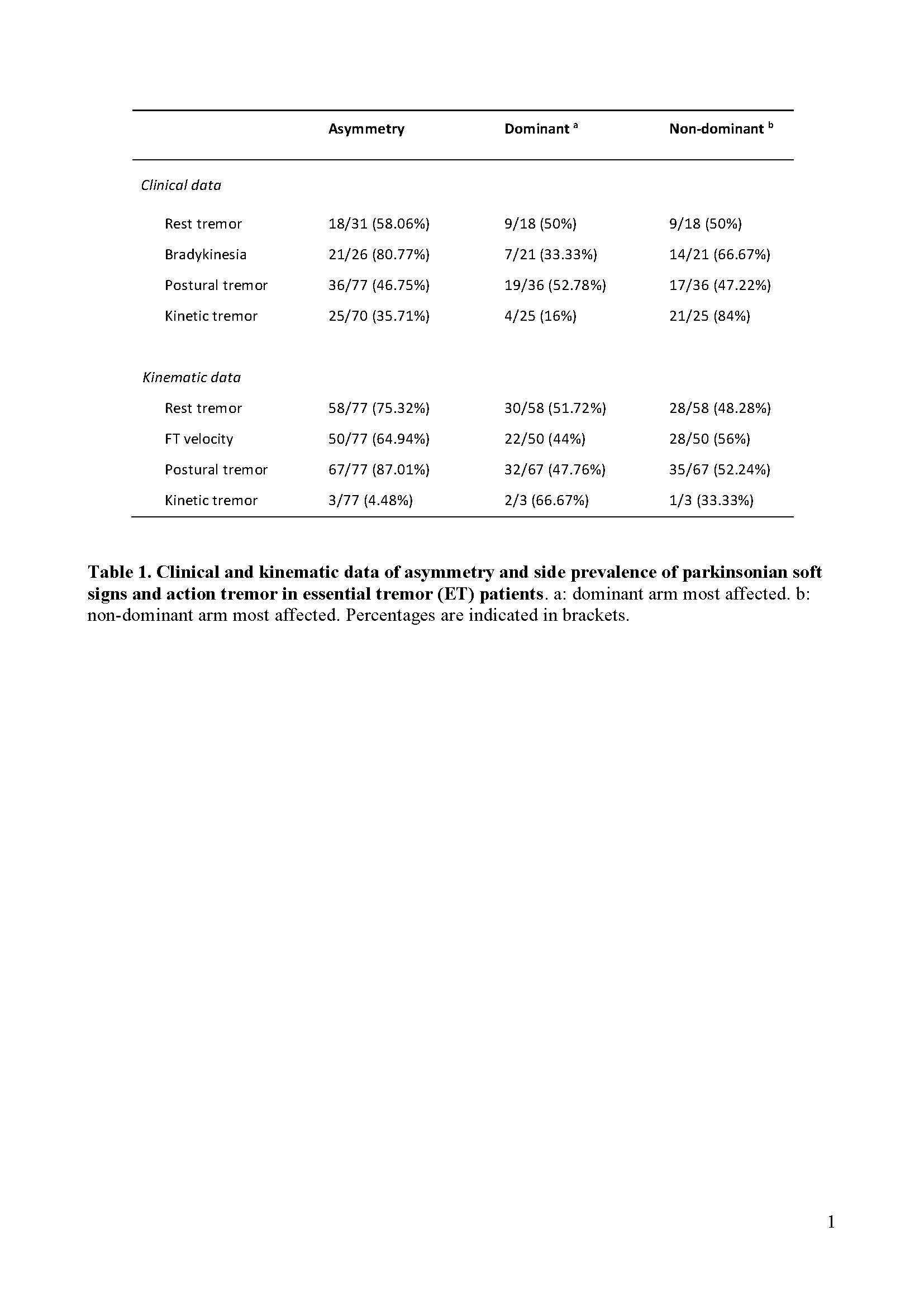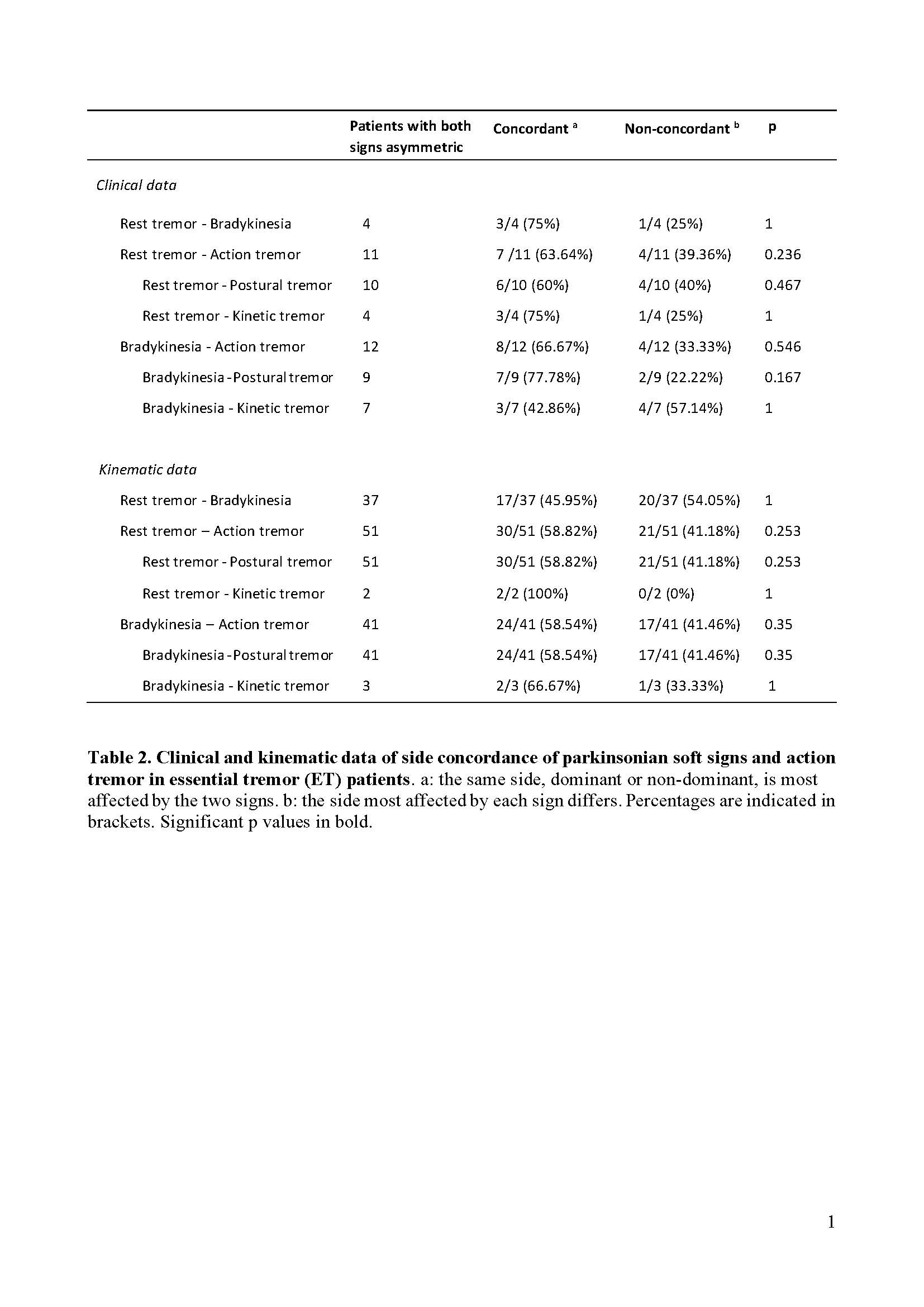Category: Tremor
Objective: In the present study, we aimed to investigate the clinical and kinematic features of rest tremor and bradykinesia in patients with essential tremor (ET), with a focus on body distribution and side concordance among them and with action tremor.
Background: Subtle parkinsonian signs, i.e., rest tremor and bradykinesia, can occur in patients with essential tremor (ET) and can be considered soft signs for the definition of ET-plus. Little is known about the asymmetry of these motor manifestations in ET, and the relationship among them is still largely unclear.
Method: In a sample of 77 ET patients we used standardized clinical scales and a kinematic system for movement analysis to assess tremor in different activation conditions and movement velocity during repetitive finger movements. We compared ET patients with rest tremor (ETr) and bradykinesia (ETb) with ET patients without soft signs, and then we investigated asymmetry and side concordance of the different motor symptoms.
Results: Rest tremor and slight bradykinesia were clinically detectable in 31 and 26 out of 77 patients (40,26% and 33,77%) respectively. ETr and ETb groups showed higher FTM-TRS total score and subscores than ET patients without soft signs, and ETr also showed a higher number of body segments involved. A high prevalence of asymmetry of the different motor symptoms was observed (Table 1). In the groups of patients showing two of the motor manifestations (rest tremor, bradykinesia and action tremor – considering separately postural and kinetic tremor), neither clinical examination nor kinematic analysis revealed a significant side concordance (Table 2).
Conclusion: Rest tremor and bradykinesia are relatively frequent in ET and often asymmetric. Our findings suggest that these parkinsonian soft signs in ET possibly reflect different pathophysiological mechanisms, probably involving basal ganglia and cerebellum networks. The relationship of these manifestations with action tremor in ET needs to be clarified by further investigations, also with the perspective of a better classification of tremor.
References: Bhatia KP, Bain P, Bajaj N, Elble RJ, Hallett M, Louis ED, Raethjen J, Stamelou M, Testa CM, Deuschl G; Tremor Task Force of the International Parkinson and Movement Disorder Society. Consensus Statement on the classification of tremors. from the task force on tremor of the International Parkinson and Movement Disorder Society. Mov Disord. 2018 Jan;33(1):75-87. doi: 10.1002/mds.27121. Epub 2017 Nov 30. PMID: 29193359; PMCID: PMC6530552.
Bologna M, Paparella G, Colella D, Cannavacciuolo A, Angelini L, Alunni-Fegatelli D, Guerra A, Berardelli A. Is there evidence of bradykinesia in essential tremor? Eur J Neurol. 2020 Aug;27(8):1501-1509. doi: 10.1111/ene.14312. Epub 2020 May 31. PMID: 32396976.
Delgado N, Berry DS, Louis ED. Distribution of rest tremor in patients with Essential Tremor: Does it lateralize with simple kinetic, postural, or intention tremors? Parkinsonism Relat Disord. 2022 Sep;102:36-41. doi: 10.1016/j.parkreldis.2022.07.018. Epub 2022 Jul 31. PMID: 35933821.
To cite this abstract in AMA style:
L. Angelini, G. Paparella, D. Costa, D. Birreci, A. Cannavacciuolo, M. Passaretti, D. Colella, A. Berardelli, M. Bologna. Asymmetry and side concordance of rest tremor and bradykinesia in patients with essential tremor [abstract]. Mov Disord. 2023; 38 (suppl 1). https://www.mdsabstracts.org/abstract/asymmetry-and-side-concordance-of-rest-tremor-and-bradykinesia-in-patients-with-essential-tremor/. Accessed December 16, 2025.« Back to 2023 International Congress
MDS Abstracts - https://www.mdsabstracts.org/abstract/asymmetry-and-side-concordance-of-rest-tremor-and-bradykinesia-in-patients-with-essential-tremor/


